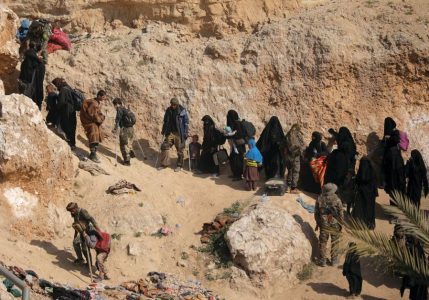
At least 9000 ISIS terrorists and 60000 family members held in Syria
A new report on CNN reveals the extent of the amount of ISIS detainees now held in Syria, after tens of thousands surrendered in the last several months of fighting. ISIS was largely defeated in Baghouz in March and around 60,000 of its members were taken into custody. Although ISIS sleeper cells still pose a threat, a much larger challenge is now posed by how to deal with the detainees.
The US-led coalition and the Syrian Democratic Forces now must deal with a large population of ISIS members who face an unclear future. A US defense official told CNN that over 1,000 of them held by the SDF have been identified as foreign nationals. But the actual numbers are more complex.
There were already up to 3,200 ISIS members held by the SDF before the offensive against Hajin and Baghouz began last September. These included up to 900 fighters and thousands of family members. It also included large numbers of foreigners from 41 countries, according to statements at the time.
During the battles for the ISIS-held area around Baghouz on the Euphrates, another 60,000 people surrendered. They are now housed at AL Hol camp in Syria. The CNN reports note that there are now 73,041 people in Al Hol camp, with 65% under age 18. The camp’s population is 42% Iraqi and 15% from other countries, with the remaining people being Syrians.
There are also 9,000 ISIS fighters “being held by the US-backed SDF, with the majority of those being Syrian and Iraqi nationals,” CNN reports. Those at the camp, which are mostly women and children, are viewed as ISIS “affiliates.” The US confirmed to CNN that 1,000 “foreign terrorist fighters from more than 50 countries” had been identified. To identify them, biometrics were used, as well as fingerprints and other methods. This took place as the male ISIS fighters left Baghouz. It is thought that when all the investigations are done, the number of these foreigners will rise.
The numbers leave many questions. What about the foreign fighters already in custody before last September? Are these part of the 1,000 terrorist fighters from fifty countries? If 15% of the more than 74,000 people in Al Hol are not from Syria or Iraq, that means around 11,000 people will eventually want to be repatriated.
Few countries have agreed to take back their ISIS citizens who went to Syria and Iraq in 2014-2015 to commit genocide and crimes against humanity. Although some countries and places have taken back the women and children, such as Tajikistan and Chechnya in Russia, most don’t take them back. Infamously, the UK has refused to take back several high profile citizens who joined ISIS.
The thousand male foreign fighters from fifty countries therefore represent only the hard-core tip of the iceberg of the ISIS members. They pose a major threat, but the international community has not set on a course of what to do with them. The US now wants the SDF to continue to house these detainees. But for a poor area of Syria, it is difficult to house not only the dangerous men, but also care for the large number of families who are the equivalent of a city in Syria now. There are so many children that special care is needed for them as well. And this doesn’t begin to address de-radicalization.
By all reports and appearances the Al Hol camp has become a well contained enclosure for ISIS ideology to percolate without any members of the coalition devoting resources to the kinds of de-radicalization programs that Gulf states and other regional countries have pioneered.
Iraq appears ready to take back most of its ISIS member citizens, whom it will put on trial. That could include the 31,000 Iraqis in Al Hol. Many of these are children, but the adults may face charges. Iraq has dealt swiftly with ISIS members, executing some who were charged with crimes against humanity.
No courts in Syria have been established to deal with the rest of the foreigners or the tens of thousands of local Syrian ISIS members. The SDF has made local deals with tribes, allegedly releasing some local Syrian ISIS members to a local tribe after agreements that the tribe would be responsible for de-radicalizing its own tribal members.
Whether this has proven successful is unclear, like the lack of clarity involving most of the ISIS members. However, the progress in biometrics shows that eventually, we may know who all these ISIS members are – even if no one knows what to do with them in the long term.
Yazidi activists are calling for justice and prosecution of those ISIS members involved in the 2014 genocide against Yazidis in Iraq. They also want to know the fate of 3,000 missing Yazidis. However, the coalition has not made investing these ISIS crimes a priority in the past, concentrating on defeating the Islamic terrorist group instead. Now, the next phase begins.
Source: JP





